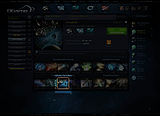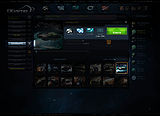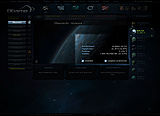Mudanças entre as edições de "Tutorial:Colonisation"
(→Colony sizes and temperatures) |
|||
| Linha 36: | Linha 36: | ||
==Colony sizes and temperatures== | ==Colony sizes and temperatures== | ||
| − | + | Below is an empirical investigation into colony sizes and temperatures. The given temperature is always the second number shown on the ingame overview screen; for example if you had "Temperature 7°C to 47°C", 47°C would be used. | |
{{Overview-PlanetParameter}} | {{Overview-PlanetParameter}} | ||
Edição das 19h00min de 29 de dezembro de 2010
At the beginning every player gets automatically assigned his home planet to construct his buildings there. But that does not suffice in the long run to keep up with other players – if you do not develop new planets, you will notice very fast, that you will stay behind the other players. Although the creation of new colonies is very costly at the beginning of the game, it gives a good return again. More planets mean more mines and more planets from which your fleets can go on raids, which means a bigger raid area. That is why it is important to research as fast as possible the astrophysics and the colony ships to expand your empire gradually.
How to colonize planets ?
To colonize a new planet you need a colony ship – a special unit, which has only that function. However, to build it you need the impulse drive on level 3, and the building costs of 10.000 metal, 20.000 crystal and 10.000 deuterium are far from cheap. Anyhow it is profitable to save the accordant amount of resources early to build colony ships. To colonize a second planet the astrophysics must be on level 1, at least. For each further planet you have to research 2 extra levels of that technology.
As soon as the needed level of the astrophysics is done and a colony ship is available, you can look for a position in the galaxy view to colonize. It will only be possible, if there is no other player on this position, hence the line is empty and if the level of the astrophysics suffices for this position ( with level 1: 4 – 12, with level 4: 3 – 13, with level 6: 2 – 14, with level 8: 1 – 15). If you have found a place, you will have to elect a colony ship and to send it with the mission “colonize” to the accordant coordinates. Normally you have to be patient for a few hours, because the colony ship is anything but fast.
As soon as the ship achieves the approached coordinates, one of these three cases will happen, according to the given situation:
- The position could be colonized and your empire was expanded with one further planet. The colony ship disappears; instead the common resources for the start appear on the new colony. Resources, which have been picked up additionally by the colony ship, will also be credited there.
- Another player has already colonized the position you have had approached or a planet has been abandoned there quite recently. Your colony ship adjourns home again and is soon ready for a new try.
- You do not have the needed level of the astrophysics, the colony ship returns in vain.
What do I have to bear in mind ?
Jeder neue Planet kostet ein Kolonieschiff, was vor allem zu Beginn des Spiels nicht gerade wenig ist. Aus diesem Grund sollte man zu dieser Zeit erstmal jeden Planeten behalten und dort Minen bauen um die eigene Wirtschaft zu stärken. Doch im weiteren Spielverlauf wird die Größe der Planeten immer wichtiger, da immer mehr Minen und sonstige Gebäude errichtet werden müssen. Zu angemessener Zeit sollte man sich also von seinen zu klein geratenen Kolonien trennen und diese durch größere Planeten ersetzen - die meisten Spieler legen 200 Felder als Untergrenze fest. Von da an sollte auch jeder neu besiedelte Planet, welcher diesem Anspruch nicht genügt, sofort wieder vernichtet werden - damit verliert man zwar die Ressourcen, doch der Schaden, welcher ein zu kleiner Planet im weiteren Spielverlauf anrichtet ist bedeutend größer. Wurde ein Planet zerstört, entsteht dort ein Asteroidenfeld, welches 24 bis 48 Stunden bestehen bleibt und diese Position für Kolonieschiffe sperrt - erst danach kann man wieder ein Schiff vorbei schicken und erneut sein Glück versuchen. Die Löschung von Asteroidenfeldern erfolgt immer um 1:20 Uhr in der Nacht.
Which position shall I colonize ?
The size of the planet will be defined not until with the colonization and it is very random. So you cannot know in advance, if the planet of your dreams with more than sufficient fields occurs this time, or just a useless boulder again. However you can control it with the choice of the position. The more the planet is at the outer edge of the solar system, the lower is the chance to get a useable planet there. In contrast the central positions 7, 8 and 9 often produce useable colonies.
But there is another reason why the position of the planet is important: try to imagine that the fixed star of the solar systems in OGame is on position 0, while disregarding the distance. The more above in the galaxy view, the closer the planet is at the sun. The outcome of this is a difference in temperature. Because of that, two important attributes for a decision are the result: the energy production of the solar satellites and the production of the deuterium synthesizer. The closer the planet is at the sun, the more efficient the solar satellites can work, and that is of particular importance to achieve the necessary energy for the graviton technology. But also miners or other players, who count on that energy source, will have problems with a halved production. To balance those cons: the colder the planets, the more the deuterium production is boosted – why planets, which are more down, are suited better for the production of that worthwhile resource.
Colony sizes and temperatures
Below is an empirical investigation into colony sizes and temperatures. The given temperature is always the second number shown on the ingame overview screen; for example if you had "Temperature 7°C to 47°C", 47°C would be used.
| Position | Planet temperature | Satellite energy | Deut. level 10 | Deut. level 30 | Fields | ||||||||||||
|---|---|---|---|---|---|---|---|---|---|---|---|---|---|---|---|---|---|
| minimum | ø | maximum | minimum | maximum | minimum | maximum | minimum | maximum | minimum | ø | maximum | ||||||
| 1 | 220°C | 240°C | 260°C | 60 | 66 | 103 | 145 | 2.093 | 2.931 | 95 | 100 | 108 | |||||
| 2 | 170°C | 190°C | 210°C | 51 | 58 | 155 | 197 | 3.140 | 3.978 | 97 | 103 | 110 | |||||
| 3 | 120°C | 140°C | 160°C | 43 | 50 | 207 | 248 | 4.187 | 5.025 | 98 | 118 | 137 | |||||
| 4 | 70°C | 90°C | 110°C | 35 | 41 | 259 | 300 | 5.234 | 6.072 | 123 | 164 | 203 | |||||
| 5 | 60°C | 80°C | 100°C | 33 | 40 | 269 | 311 | 5.444 | 6.281 | 148 | 179 | 213 | |||||
| 6 | 50°C | 70°C | 90°C | 31 | 38 | 280 | 321 | 5.653 | 6.491 | 148 | 194 | 227 | |||||
| 7 | 40°C | 60°C | 80°C | 30 | 36 | 290 | 331 | 5.862 | 6.700 | 141 | 193 | 238 | |||||
| 8 | 30°C | 50°C | 70°C | 28 | 35 | 300 | 341 | 6.072 | 6.909 | 163 | 208 | 247 | |||||
| 9 | 20°C | 40°C | 60°C | 26 | 33 | 311 | 352 | 6.281 | 7.119 | 155 | 197 | 238 | |||||
| 10 | 10°C | 30°C | 50°C | 25 | 31 | 321 | 363 | 6.491 | 7.328 | 154 | 188 | 223 | |||||
| 11 | 00°C | 20°C | 40°C | 23 | 30 | 331 | 373 | 6.700 | 7.538 | 146 | 176 | 204 | |||||
| 12 | -10°C | 10°C | 30°C | 21 | 28 | 342 | 383 | 6.909 | 7.747 | 136 | 154 | 171 | |||||
| 13 | -50°C | -30°C | -10°C | 15 | 21 | 383 | 425 | 7.747 | 8.585 | 109 | 115 | 121 | |||||
| 14 | -90°C | -70°C | -50°C | 8 | 15 | 425 | 466 | 8.585 | 9.422 | 81 | 86 | 93 | |||||
| 15 | -130°C | -110°C | -90°C | 1 | 8 | 466 | 508 | 9.422 | 10.260 | 65 | 69 | 74 | |||||





